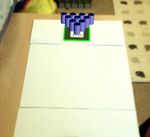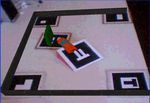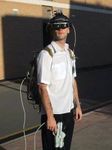Physics-Based Table-Top Mixed Reality Games
←
→
Page content transcription
If your browser does not render page correctly, please read the page content below
Physics-Based Table-Top Mixed Reality Games
Qingqing Dong, Zhongyi Sun & Brian Mac Namee
School of Computing, Dublin Institute of Technology, Kevin St., Dublin 8, Ireland
Keywords: Mixed reality, games, augmented reality, computer vision, physics
Abstract
Mixed reality applications use techniques from computer vision, augmented reality and virtual reality
to allow real and virtual objects interact physically together on a user’s computer screen. This paper
will describe two mixed reality applications which allow the user to play games that appear to take
place on top of their physical desk. The games described are a desktop racing game and a desktop
based game of ten pin bowling. In the desktop racing game virtual cars, controlled by the user,
interact with both virtual objects (such as trees, walls and lampposts) and real ones (such as ramps
and blocks). In the bowling game the player throws a real ball at a set of virtual bowling pins which
react realistically as the ball appears to hit them. These initial games are being used as a springboard
to investigate the core competencies required to make mixed reality games.
Introduction
Drawing on techniques from the fields of computer vision, augmented reality and virtual
reality, mixed reality applications (Milgram et al, 1994) bring together real and virtual
objects in applications where they interact closely together. This offers potential unique
interactions not possible in other applications. One area where these potentials sit ready to
be exploited is that of computer games. Recent innovations in computer game control
techniques such as the Sony EyeToy1 and the Nintendo Wii Remote2 show the potential for
such novel interaction paradigms. Mixed reality techniques could free game players from
the confines of traditional game controllers making possible some very interesting
possibilities.
Figure 1: Screenshots of the two mixed reality physics-based table top games described in this
paper
1
http://www.eyetoy.com/
2
http://www.nintendo.com/wii/This paper will describe two mixed reality games in development at the DIT Experimental
Games Group (EGG)3 that are played on the physical desktop of a user and mix together real
and virtual objects to create interesting game-play possibilities. The first of these games is a
driving game in which the player drives a car around on the top of their desk performing
stunts using real and virtual obstacles. The second game is a mixed reality bowling game in
which the player throws a real bowling ball at a virtual set of bowling pins. Screenshots from
both of these games are shown in figure 1.
The next section of this paper will gave a background to mixed reality applications, including
some existing games. The section after this will then describe our games, including a
description of the technologies used and the lessons learned in developing them. Finally,
some conclusions as to interesting avenues in which to take mixed reality applications will
be drawn along with some suggestions as to what we intend to do next.
Mixed Reality Environments
In one of the earlier works on the subject, Milgrim et al (1994) define a mixed reality
environment as “one in which real world and virtual world objects are presented together”.
However, this leaves open a very large number of possibilities and so Milgrim et al propose a
spectrum of mixed reality environments (reproduced in figure 2). This spectrum places real
environments on one end, totally virtual environments on the other, and various blends of
mixed reality environments across the remainder of the spectrum. Major classes of
applications in this range include augmened reality (AR), in which a predominantly real
environment is augmented with virtual objects (Bimber & Raskar, 2005, Green et al, 2008),
and augmented virtuality (AV) in which a predominantly virtual envrionment is augmented
with real ojects (Regenbrecht et al, 2003, Wang, 2007).
Figure 2: Milgrim’s mixed reality spectrum
The applications described in this work fit squarely at the centre of this spectrum, rather
than towards either end. This is due to the fact that they allow such close interaction
between virtual and real objects. Virtual objects are physically modelled and are affected by
real ones – for example a virtual car crashing into a real obstacle, or a real bowling ball
knocking over a virtual bolwing pin.
In order to implement a mixed reality application there are a number of technical challenges
that must be overcome. While this paper will not discuss any of these in detail it is worth
mentioning the most important ones. Firstly, in order to allow real and virtual objects
interact believably with one-another accurate tracking of real objects must be achieved.
There is a large body of work from the field of computer vision on how to achieve this
(Comaniciu, et al, 2003, Trucco & Plakas, 2006), but it is worth noting that often simple
“cheats” are used such as only tracking black objects against white backgrounds or using
special markers. Related to this first issue is the issue of registering real and virtual
environments. This is one of the main concerns of augmented reality research. One of the
most common solutions is the use of fiducial markers (such as the black and white square
patterns shown in figure 1) which can be easily recognized from camera images and allow a
transformation from the camera position to the marker position to be calculated. This is
3
http://www.seriousgames.ie/important so that virtual objects appear in the correct positions and appear correctly aligned
to real objects.
Modelling the physical interactions between virtual and physical objects is another key
challenge. This is achieved by giving real objects a virtual alias within the physics simulation
of a scene, which can then cause interactions with virtual objects. One of the key challenges
here is making these interactions appear believable, and this generally involves a large
amount of trial and error based tweaking of parameters such as mass and density. Finally,
the virtual objects in a scene must be rendered in such a way as to make it appear that they
exist seamlessly alongside the real objects in the scene. Shadowing, occlusion and rendering
techniques can be used for this.
Without achieving each of these it is not possible to create a successful game of the type
that we are looking to make. There has, though, been some very interesting work in the area
and some very interesting games have been created.
Mixed Reality Games
One of the most exciting mixed reality games developed in recent years has been ARQuake
(Thomas, 2003), an AR game that extends the famous computer game Quake4. In the
original Quake the player takes on the role of a soldier in a game played from a first person
perspective and controlled using a combination of a keyboard and mouse. ARQuake used AR
technology to bring Quake into the real world. Players can see virtual monsters in their real
environment through a see-through head-mounted-display (HDM) (figure 3 (A)). Control is
based on the player moving through their real environment and using a special gun shaped
controller. An example of the ARQuake experience is shown in figure 3 (B). ARQuake is
notable for its ambition to bring virtual objects into such a freeform and large environment.
(A) (B)
(C) (D)
Figure 3: (A) The ARQuake equipment, (B) a screenshot of ARQuake, (C) Phone Tennis being
played, and (D) people playing Eye of Judgement.
4
http://www.idsoftware.com/Phone Tennis (Henrysson et al, 2005) is another interesting mixed reality game, this time
played on mobile phones. As shown in figure 3 (C), using their phones as racquets, players
play tennis on a virtual tennis court which is located on a table top using ficucial markers.
This game is paricularly intersting as it blurs the lines beteweeen physical and virtual
interactions and how virtual and physical objects can effect each other.
Finally, the Eye of Judgment5 is interesting as it is the first commercially available mixed
reality game. Released in 2008 by Sony Computer Entertainment for their PlayStation 3
console, the Eye of Judgement is a card based fighting game in the vein of Pokemon6.
However, in the game a camera is placed above the playing surface which detects when
certain cards are played, and displays 3 dimenional monsters on top of these cards on a
connected television. An example of this is shown in figure 3 (D). While the game does not
make paricularly novel use of mixed reality techniques, it is worth mentioning for being a
commercial game resleased on a major console.
Our Games
This section will describe two table-top physics based mixed reality games in development
by the DIT EGG. The first of these is a car game, Table-Top MR Racing, in which virtual cars
appear to drive around the player’s desk interacting with a range of virtual and physical
objects. The second is an implementation of ten-pin bowling, Table-Top MR Bowling, in
which the player uses a real ball rolled across their desk to knock over virtual pins. Both of
these games use ARToolkit7 to locate fiducial markers for registration, the ODE physics
engine8 for physics modelling, and OpenGL9 for rendering.
(A) (B)
Figure 4: (A) The Table-Top MR Racing game set up and (B) a screenshot of the resulting game
Figure 4 shows the setup (A) used for the racing game, and a screenshot (B) of what is
displayed to the user. In this case the mixed reality version of the game is displayed via a
monitor positioned at the edge of the game area (however, there is no reason why this
could not be replaced with a HMD is the future). To play the game a selection of fiducial
markers are laid out on a desk over which a camera is placed. The four outermost markers
represent the boundaries of the playing area. Three sides of the playing area are walled in
with virtual barriers, while the third side is assumed to be the edge of the playing surface. If
a car is driven over the edge of the playing surface it is shown falling to the ground. The
other fiducial markers represent objects that are used within the game. Supported objects
include cars, ramps, tree, and piles of boxes.
5
http://www.eyeofjudgment.com/
6
http://www.pokemon.com/
7
http://www.hitl.washington.edu/artoolkit/
8
http://www.ode.org/
9
http://www.opengl.org/Where we believe the game becomes particularly interesting is when real objects are
introduced and allowed to interact with the virtual ones. The large box in the middle of
figure 4 (B) is one such example. The box has a fiducial marker placed on top of it which is
recognized by the system’s vision module. A physical model of the box is then used within
the physics simulation used to run the game. At present this model is based on pre-
programmed parameters that describe the physical box. In the current version of the game
a physical ramp (modelled in the same way) is also available – this can be seen in figure 1.
(A) (B)
Figure 5: Table-Top MR Racing before (A) and after (B) implementing occlusion.
Probably the most important challenge in making the interactions between real and virtual
objects appear believable is to achieve realistic occlusion – virtual objects must appear to be
hidden when they pass behind real objects. An example of this is shown in figure 5, where in
(A) no occlusion is implemented, while in (B) it is. When the game is running the difference
between the level of believability achieved with and without occlusion is remarkable and
this has been borne out in the user evaluations that have been undertaken so far. The
technique used to implement occlusion is relatively simple and relies on manipulating the
OpenGL depth buffer, however the details of this go beyond the scope of this paper.
(A) (B)
Figure 6: (A) A screenshot of Table-Top MR Bowling and (B) a description of how interaction
between the real ball and virtual pins is achieved.
Table-Top MR Bowling uses many of the same techniques as the racing game. This time a
camera is placed above the player’s table which acts as a bowling alley. A single fiducial
marker is placed on this table at the position where the pins are to appear. The player thenthrows a real ball towards the virtual pins which are realistically knocked over. This setup is
shown in figure 6 (A).
Figure 6 (B) shows how the ball tracking and interaction with the pins is achieved. Within a
small section of the alley the real ball is tracked and it’s trajectory and speed are measured.
Once the ball exits this area it is no longer tracked and instead an invisible virtual ball (with
the same physical characteristics as the real one) is simulated along the real ball’s predicted
trajectory. This virtual representation of the ball then interacts with the virtual pins causing
the illusion that they are being knocked over by the real ball.
Conclusions & Future Work
This paper has discussed two mixed reality physics-based games that are played on a
player’s table-top. These games show that it is possible to create interesting play
environments that mix real and virtual objects which interact physically together. While in
themselves the games serve as entertaining diversions, they also serve as a first step in
identifying the key competencies that are required to develop such games. These include
object tracking, registration between virtual and real objects, physics modeling and
rendering techniques. This is the direction in which we hope to take the research in the
future, with the ultimate goal of developing a set of tools (making use of existing tools such
as ARToolkit and ODE) to allow making such games straightforward.
References
Bimber, O. & R. Raskar (2005). “Spatial Augmented Reality: Merging Real and Virtual Worlds”. A K
Peters LTD, 2005.
Comaniciu, D., V. Ramesh & P. Meer, (2003) “Kernel-based object tracking”, IEEE Transactions on
Pattern Analysis and Machine Intelligence, Vol. 25, No. 5., pp. 564-577, 2003.
Green, S.A., M. Billinghurst, X.Q. Chen & J. G. Chase, (2008), “Human-Robot Collaboration: A
Literature Review and Augmented Reality Approach in Design”, Page 01-18 International Journal
of Advanced Robotic Systems, Volume 5 Number 1, 2008.
Henrysson, A., M. Billinghurst & M. Ollila, (2005), “Face to Face Collaborative AR on Mobile Phones”,
In Proceedings of the Fourth IEEE and ACM International Symposium on Mixed and Augmented
Reality (ISMAR’05), 2005.
Milgram, Paul, Haruo Takemura, Akira Utsumi & Fumio Kishino, (1994) “Augmented Reality: A class of
displays on the reality-virtuality continuum”, SPIE Vol. 2351, Telemanipulator and Telepresence
Technologies, 1994.
Regenbrecht, H., C. Ott, M. Wagner, T. Lum, P. Kohler, W. Wilke & E. Mueller, (2003), “An Augmented
Virtuality Approach to 3D Videoconferencing”, In Proceedings of the 2nd IEEE/ACM International
Symposium on Mixed and Augmented Reality, 2003.
Thomas, B.H., (2003) “Challenges of Making Outdoor Augmented Reality Games Playable”, In 2nd
CREST Workshop on Advanced Computing and Communicating Techniques for Wearable
Information Playing, 2003.
Trucco, E., K. Plakas, (2006), “Video Tracking: A Concise Survey”, IEEE Journal of Oceanic Engineering,
Vol. 31, No. 2., pp. 520-529, 2006.
Wang, X., (2007), “Specifying Augmented Virtuality Systems for Creative Architectural Design”, In
Proceedings of the 11th International Conference on Information Visualization (IV '07), 2007.You can also read



























































